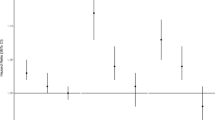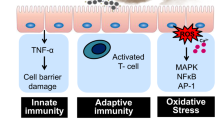Abstract
By convention, airborne particles ≤0.1 μm (100 nm) are defined as ultrafine particles (UFPs). UFPs can comprise a large number of particles in particulate matter with aerodynamic diameters ≤2.5 μm (PM2.5). Despite the documented respiratory health effects of PM2.5 and concerns that UFPs might be more toxic than larger particular matter, the effects of UFPs on the respiratory system are not well-described. Even less is known about the respiratory health effects of UFPs among particularly vulnerable populations including children. We reviewed studies examining respiratory health effects of UFPs in children and identified 12 relevant articles. Most (8/12) studies measured UFP exposure using central ambient monitors, and we found substantial heterogeneity in UFP definitions and study designs. No long-term studies were identified. In single pollutant models, UFPs were associated with incident wheezing, current asthma, lower spirometric values, and asthma-related emergency department visits among children. Also, higher exhaled nitric oxide levels were positively correlated with UFP dose among children with asthma or allergy to house dust mites in one study. Multivariate models accounting for potential copollutant confounding yielded no statistically significant results. Although evidence for a relationship between UFPs and children’s respiratory is accumulating, the literature remains inconclusive. Interpretation of existing data is constrained by study heterogeneity, limited accounting for UFP spatial variation, and lack of significant findings from multipollutant models.
Similar content being viewed by others
References
Andersen, Z. J., et al. (2008a). Ambient air pollution triggers wheezing symptoms in infants. Thorax, 63, 710–6.
Andersen, Z. J., et al. (2008b). Size distribution and total number concentration of ultrafine and accumulation mode particles and hospital admissions in children and the elderly in Copenhagen. Denmark. Occup Environ Med., 65, 458–66.
Boehmer, T. K., et al. (2013). Residential proximity to major highways - United States, 2010. MMWR Surveillance Summaries, 62(Suppl 3), 46–50.
Boothe, V. L., et al. (2014). Residential traffic exposure and childhood leukemia: a systematic review and meta-analysis. American Journal of Preventive Medicine, 46, 413–22.
Bowatte, G., et al. (2014). The influence of childhood traffic related air pollution exposure on asthma, allergy and sensitization: a systematic review and a meta-analysis of birth cohort studies. Allergy.
Buonanno, G., et al. (2012). Individual dose and exposure of Italian children to ultrafine particles. The Science of the Total Environment, 438, 271–7.
Buonanno, G., et al. (2013). Health effects of daily airborne particle dose in children: direct association between personal dose and respiratory health effects. Environmental Pollution, 180, 246–50.
Chung, Y., et al. (2015). Associations between long-term exposure to chemical constituents of fine particulate matter (PM2.5) and mortality in Medicare enrollees in the eastern United States. Environmental Health Perspectives, 123, 467–74.
Diapouli, E., et al. (2008). Indoor and outdoor PM mass and number concentrations at schools in the Athens area. Environmental Monitoring and Assessment, 136, 13–20.
Diaz-Robles, L. A., et al. (2014). Health risks caused by short term exposure to ultrafine particles generated by residential wood combustion: a case study of Temuco. Chile. Environ Int., 66, 174–81.
Evans, K. A., et al. (2014). Increased ultrafine particles and carbon monoxide concentrations are associated with asthma exacerbation among urban children. Environmental Research, 129, 11–9.
Ezz, W. N., et al. (2015). Ultrafine Particles from Traffic Emissions and Children’s Health (UPTECH) in Brisbane, Queensland (Australia): study design and implementation. International Journal of Environmental Research and Public Health, 12, 1687–702.
Gauderman, W. J., et al. (2015). Association of improved air quality with lung development in children. The New England Journal of Medicine, 372, 905–913.
Gong, L., et al. (2009). Ultrafine particles deposition inside passenger vehicles. Aerosol Science and Technology, 43, 544–553.
Halonen, J. I., et al. (2008). Urban air pollution, and asthma and COPD hospital emergency room visits. Thorax, 63, 635–41.
HEI Review Panel on Ultrafine Particles. (2013). Understanding the health effects of ambient ultrafine particles. HEI Perspectives 3. Boston: Health Effects Institute.
Herner, J., et al. (2006). Dominant mechanisms that shape the airborne particle size and composition distribution in central California. Aerosol Science and Technology, 40, 827–844.
Institute of Medicine (US) Committee on the Assessment of Asthma and Indoor Air. (2000). Clearing the air: asthma and indoor air exposures. Washington: National Academies Press (US).
Iskandar, A., et al. (2012). Coarse and fine particles but not ultrafine particles in urban air trigger hospital admission for asthma in children. Thorax, 67, 252–7.
Karner, A. A., et al. (2010). Near-roadway air quality: synthesizing the findings from real-world data. Environmental Science & Technology, 44, 5334–44.
Kim, J. L., et al. (2011). Respiratory health among Korean pupils in relation to home, school and outdoor environment. Journal of Korean Medical Science, 26, 166–73.
Kreyling, W. G., et al. (2006). Ultrafine particle-lung interactions: does size matter? Journal of Aerosol Medicine, 19, 74–83.
Laumbach, R. J., & Kipen, H. M. (2012). Respiratory health effects of air pollution: update on biomass smoke and traffic pollution. The Journal of Allergy and Clinical Immunology, 129, 3–11. quiz 12–3.
McCreanor, J., et al. (2007). Respiratory effects of exposure to diesel traffic in persons with asthma. The New England Journal of Medicine, 357, 2348–58.
Nazaroff, W. W. (2004). Indoor particle dynamics. Indoor Air, 14(Suppl 7), 175–83.
Newcomb, P., et al. (2012). Acute effects of walking environment and GSTM1 variants in children with asthma. Biological Research for Nursing, 14, 55–64.
Ostro, B., et al. (2015). Associations of mortality with long-term exposures to fine and ultrafine particles, species and sources: results from the California Teachers Study Cohort. Environmental Health Perspectives, 123, 549–56.
Patton, A. P., et al. (2015). Transferability and generalizability of regression models of ultrafine particles in urban neighborhoods in the Boston area. Environmental Science & Technology, 19, 6051–60.
Pekkanen, J., & Kulmala, M. (2004). Exposure assessment of ultrafine particles in epidemiologic time-series studies. Scandinavian Journal of Work, Environment & Health, 30(Suppl 2), 9–18.
Pekkanen, J., et al. (1997). Effects of ultrafine and fine particles in urban air on peak expiratory flow among children with asthmatic symptoms. Environmental Research, 74, 24–33.
Peterson, B.S., et al. (2015). Effects of prenatal exposure to air pollutants (polycyclic aromatic hydrocarbons) on the development of brain white matter, cognition, and behavior in later childhood. JAMA Psychiatry.
Pietropaoli, A. P., et al. (2004). Pulmonary function, diffusing capacity, and inflammation in healthy and asthmatic subjects exposed to ultrafine particles. Inhalation Toxicology, 16(Suppl 1), 59–72.
Polidori, A., et al. (2013). Pilot study of high-performance air filtration for classroom applications. Indoor Air, 23, 185–95.
Pope, C. A., 3rd, & Dockery, D. W. (2006). Health effects of fine particulate air pollution: lines that connect. Journal of the Air and Waste Management Association, 56, 709–42.
Roemer, W., et al. (1999). Inhomogeneity in response to air pollution in European children (PEACE project). Occupational and Environmental Medicine, 56, 86–92.
Schuepp, K., & Sly, P. D. (2012). The developing respiratory tract and its specific needs in regard to ultrafine particulate matter exposure. Paediatric Respiratory Reviews, 13, 95–9.
Spickett, J., et al. (2014). The domestic environment and respiratory health of school children in Zongshan. China. Asia Pac J Public Health., 26, 596–603.
Terzano, C., et al. (2010). Air pollution ultrafine particles: toxicity beyond the lung. European Review for Medical and Pharmacological Sciences, 14, 809–21.
Tiittanen, P., et al. (1999). Fine particulate air pollution, resuspended road dust and respiratory health among symptomatic children. The European Respiratory Journal, 13, 266–73.
U. S. Environmental Protection Agency National Ambient Air Quality Standards, http://www.epa.gov/air/criteria.html. Accessed 2 Mar 2015.
U. S. Environmental Protection Agency. (2009). 2009 Final report: integrated science assessment for particulate matter. Washington: U. S. Environmental Protection Agency. EPA/600/R-08/139F.
Weichenthal, S., et al. (2008). Characterizing and predicting ultrafine particle counts in Canadian classrooms during the winter months: model development and evaluation. Environmental Research, 106, 349–60.
Wichmann, H.E., et al. (2000). Daily mortality and fine and ultrafine particles in Erfurt, Germany part I: role of particle number and particle mass. Research Report Health Effects Institute, 5–86; discussion 87–94.
World Health Organization, International Classification of Diseases, http://www.who.int/classifications/icd/en/ Accessed 1 May 2015.
Wu, W., et al. (2015). A Bayesian approach to account for misclassification and overdispersion in count data. International Journal of Environmental Research and Public Health, 28, 10648–61.
Zhang, J.J., et al. (2009). Health effects of real-world exposure to diesel exhaust in persons with asthma. Research Report Health Effects Institute, 5–109; discussion 111–23.
Acknowledgments
The findings and conclusions in this article are those of the authors and do not necessarily represent the views of the Centers for Disease Control and Prevention.
Author information
Authors and Affiliations
Corresponding author
Ethics declarations
Conflict of Interest
The authors declare that they have no conflict of interest.
Funding Source
No external funding for this manuscript
Additional information
Both Amy Heinzerling and Joy Hsu shared first author.
Rights and permissions
About this article
Cite this article
Heinzerling, A., Hsu, J. & Yip, F. Respiratory Health Effects of Ultrafine Particles in Children: a Literature Review. Water Air Soil Pollut 227, 32 (2016). https://doi.org/10.1007/s11270-015-2726-6
Received:
Accepted:
Published:
DOI: https://doi.org/10.1007/s11270-015-2726-6




